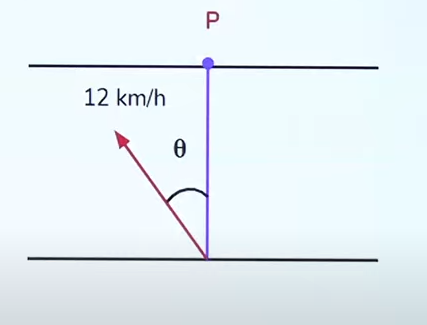A swimmer is capable of swimming 1.65ms−1 in still water.If she swims directily across a 180m wide river whose current is 0.85ms−1,how far downstreams (from a point opposite her starting point ) will she reach?
92.7m
40m
48m
20m
The correct Answer is:a
Step by step video, text & image solution for A swimmer is capable of swimming 1.65 ms^(-1) in still water.If she swims directily across a 180m wide river whose current is 0.85 ms^(-1),how far downstreams (from a point opposite her starting point ) will she reach? by Physics experts to help you in doubts & scoring excellent marks in Class 11 exams.
Updated on:21/07/2023Topper's Solved these Questions
Similar Questions
A man can swim at the rate of 5kmh−1 in still water A. One km wide river flows at the rate of 3kmh−1 . The man wishes to swim across the river directly opposite to the starting point. How much time will be take to cross the river
View SolutionA man can swim at the rate of 5kmh−1 in still water. A 1−km wide river flows at the rate of 3kmh−1 The man wishes to swim across the river directly opposite to the starting point.
(a) Along what direction must the man swim ?
(b) What should be his resultant velocity ?
( c) How much time will he take to cross the river ?
View Solution
Knowledge Check
A river flows with a speed more than the maximum speed with which a person can swim in still water. He intends to cross the river by the shortest possible path (i.e., he wants to reach the point on the opposite bank which directly opposite to the starting point). Which of the following is correct ?
AHe should normal to the river bank.BHe should start in such a way that he moves normal to the bank, relative to the bank.CHe should start in a particular (calculated) direction making an obtuse angle with the direction of water current.DThe man cannot cross the river in that way.A swimmer can swim in still water with a speed of 3 ms−1 While crossing a river his average speed is 5 ms−1 If crosses the river in the shortest possible time, what is the speed of flow of water ?
A2ms−1B4ms−1C6ms−1D8ms−1A swimmer can swim with 5ms−1 in still water. He wants to cross a river having width 200m heading perpendicular to the flow. Speed of flow is uniformly increasing from zero at side to 3ms−1 at mid from both side of the river. Then the time taken by the swimmer to cross the river will be
A40secB60secC80secD90sec
A ,man wishing to cross a river flowing with velocity u jumps at an angle θ with the river flow.
(a) Find the net velocity of the man with respect to ground if he can swim with speed v in still water.
(b) In what direction does the boat actually move ?
( c) Find how far from the point directly opposite to the starting point does the boat reach the opposite bank, if the width of the river is d.
View SolutionA river 800 m wide flows at the rate of 5kmh−1. A swimmer who can swim at 10kmh−1 in still water, wishes to cross the river straight. (i) Along what direction must be strike ? (ii) What should be his resultant velocity ? (iii) How much time he would take ?
View SolutionA boat man can rown with a speed of 10kmh−1 in still water. If the river flows steadily at 5km/h, in which direction showld the boatman row in order to reach a point on the other bank directly opposite to the point from wher he stared ? The width of the river is 2km.
View SolutionA swimmer can swim with speed 12 m/s in still water. Speed of river is 6 m/s. Find angle at which he should swim with downstream so that he reaches directly opposite point on other side

View SolutionA man can swim in still water with a speed of 2ms−1. If he wants to cross a river of water current speed √3ms−1 along the shortest possible path, then in which direction should he swim ?
View Solution
